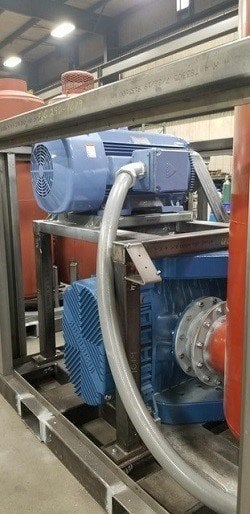Electric motors carry out essential marine tasks in offshore, coastal and inland marine environments. Oil platforms rely on pumps to drive the pumping rod, process recovered oil and transfer it to tankers. Tankers and other ships are equipped with pumps to expel bilge water, transfer fluids and ventilate the engine and decks. Air compression needs are also powered by an electric motor. Meanwhile, back at port, more transfer pumps await, as do electric motors powering many other offloading and processing equipment.
A key consideration for these electric motors is their ability to handle the environmental challenges of life at sea. Motor reliability is key to both equipment functionality and personnel safety, and a replacement might be an ocean away. There are some unique design elements for marine electric motors to ensure reliability under tough conditions.

Marine motors must withstand a constantly wet and high-humidity environment. Not only can water ingress ruin electrical components, it can also ruin materials via corrosion. This is largely solved by component material selection to prevent oxidation or galvanic corrosion.
All internal motor components will be protected by a watertight enclosure, typically with an ingress protection rating of at least IP55, and potentially higher IP ratings for high-splash, high-exposure uses. The enclosure also helps cool the internal motor components, and an external fan may increase convection around the enclosure. Additionally, bearings are typically equipped with a labyrinth seal to protect the shaft from ingress.
Below-deck applications will generally have less ventilation and are better suited for motors with a higher ambient operating temperature. Motors operating above 40° C need special attention paid to some components, including seals, insulation and bearings. Similarly, motors operating in temperatures of -20° C must consider seals, bearings and plastics. Electric motors exposed to wintery weather should be de-iced and operated within the duty cycle.
Ensuring that marine-duty electric motors are low vibration is also a chief concern. A highly engineered, quality-manufactured electric motor can be expected to maintain optimal equilibrium. As a ship or oil platform pitches and yaws with the waves and currents, each movement exerts additional force on a motor’s rotor. An unbalanced motor is more likely to succumb to damage due to high seas.
Electric propulsion is also increasingly common, not only on small vessels, but also on cargo ships, oil and gas vessels and platforms, floating cranes and other offshore vehicles. A major benefit of these systems is the ability to optimize the loading of the prime movers for the diesel engines, gas turbines and other generator types to maximize efficiency and reduce fuel consumption. Electric motors for propulsion enhance flexibility of onboard space, and power can be redirected to power lifts, auxiliary pumps and other onboard applications.
Compliance with major classification societies and standards ensures that a motor will perform according to the manufacturer and regulatory specifications. Standards compliance is indicated on the motor nameplate, along with other key motor specifications and identification.
Key among those standards is IEEE 45, which recommends design features for electrical systems and equipment on ships, including DC motors. The standard advises that motors used in below-deck applications have suitable corrosion resistance, including a coated rotor, painted components and a stainless steel nameplate. In addition, grease is the advised lubricant, as its higher viscosity makes it less likely to leak during ship rolls. Boiler and engine rooms may require an explosion-proof motor. Those motors located above-deck should be of cast iron materials and be totally enclosed. High-integrity seals and adequate lubrication are also considerations.
Additionally, the American Bureau of Shipping (ABS) conducts reviews on behalf of the U.S. Coast Guard (USCG) and issues USCG-type approval certificates after engineers verify product compliance with manufacturers’ specifications, applicable ABS rules and national or international standards. Products with an ABS rating are pre-approved for marine shipping applications, which helps expedite shipbuilding and maintenance operations.
The Hyundai Premium Efficiency Severe Duty and Hyundai IEEE-841 motors are ideal examples of severe-duty electric motors for marine applications. These models are resilient in extreme climates and environments, and are reliable in off-shore worksites. For more information on marine-duty electric motors, contact WorldWide Electric Corp.
